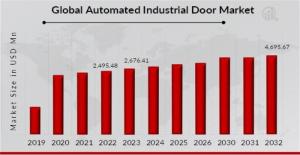Automated Industrial Door Market to hit USD 4,695.67 Million by 2032 with 7.28% CAGR | Maviflex, Novoferm GmbH, HDS
Automated Industrial Door Market grows with demand for safety, efficiency, and smart access in industrial facilities.
Automated Industrial Door Market a Comprehensive Analysis
The automated industrial door market has witnessed significant growth over the past few years, driven by technological advancements, increased demand for enhanced security, and the need for operational efficiency across various industrial sectors. Automated industrial doors, which are powered by electromechanical or hydraulic systems, are widely used in warehouses, manufacturing units, transportation hubs, and logistics centers. These doors offer numerous benefits such as improved workflow, energy efficiency, safety, and ease of access, making them an indispensable part of modern industrial infrastructure.
Automated industrial doors are specialized entry solutions designed to offer quick and secure access to buildings and restricted areas in industrial settings. These doors are commonly found in sectors like automotive, aerospace, pharmaceuticals, food and beverages, and chemicals, where they help regulate traffic, maintain temperature control, and prevent unauthorized access.
Get Free Sample PDF Brochure: https://www.marketresearchfuture.com/sample_request/5143
Key Companies in the Automated Industrial Door Market include.
Assa Abloy AB
Hart Door Systems
Gandhi Automations Pvt Ltd
AI-Barrack Industrial Group
Maviflex
RTJ Automation & Maintenance Limited
Gilgen Door Systems AG
Novoferm GmbH
Casit Srl Turin
Market Trends Highlights
Several key trends are shaping the automated industrial door market. One of the most prominent trends is the integration of smart technologies. Companies are increasingly incorporating features such as motion sensors, RFID readers, wireless communication, and predictive maintenance into their automated door systems. These features enhance user convenience, optimize maintenance schedules, and reduce operational downtime. Another major trend is the growing emphasis on energy efficiency. Industrial doors that open and close quickly help in maintaining indoor temperatures, especially in climate-sensitive environments like cold storage facilities and cleanrooms.
Additionally, the market is witnessing rising demand for customized solutions tailored to specific industrial applications. Manufacturers are offering doors with specialized materials, sizes, and automation capabilities to meet industry-specific needs. The emergence of sustainable and eco-friendly doors, made from recyclable materials and energy-efficient mechanisms, also marks a growing trend in line with global environmental regulations.
Market Dynamics
The automated industrial door market is dynamic and influenced by several interconnected factors. The rising need for efficient material handling, increased awareness of workplace safety, and advancements in building automation systems are key contributors to market growth. Industries are under pressure to optimize their supply chains and reduce energy consumption, both of which can be addressed through the implementation of automated doors. Moreover, government regulations mandating safety and accessibility standards in industrial environments further fuel market demand.
However, the market also faces challenges, such as the high installation and maintenance costs associated with advanced automated systems. Small and medium enterprises (SMEs), in particular, may find it difficult to allocate significant budgets for the installation of sophisticated doors. Additionally, technical complexities and downtime risks associated with automation systems could hinder adoption in some regions. Nonetheless, technological innovations and the emergence of cost-effective solutions are likely to mitigate these restraints in the long term.
Buy Now Premium Research Report: https://www.marketresearchfuture.com/checkout?currency=one_user-USD&report_id=5143
Market Drivers
One of the primary drivers of the automated industrial door market is the increasing focus on workplace safety and security. Industrial environments are prone to accidents and unauthorized access, and automated doors help reduce these risks by providing controlled access and minimizing manual handling. The rising prevalence of automation and robotics in industrial facilities is also driving the need for compatible infrastructure, including automated doors that can seamlessly integrate with automated workflows.
The growth of e-commerce and the logistics sector has further spurred demand for automated industrial doors, especially in warehouses and distribution centers. Fast-paced logistics operations require doors that can open and close rapidly and reliably, ensuring smooth and secure movement of goods. Additionally, urbanization and industrialization, particularly in developing economies, are leading to increased construction of industrial facilities, which in turn boosts the need for modern access solutions.
Market Restraints
Despite the numerous growth opportunities, the market is not without its constraints. The high initial cost of automated doors market remains a significant barrier, especially for budget-conscious industries and smaller organizations. While these doors offer long-term savings in energy and labor costs, the upfront investment required for automation technology, installation, and customization can be substantial.
Moreover, technological complexity and maintenance requirements pose challenges. Automated doors rely on a range of mechanical and electronic components that must function seamlessly. Any malfunction in the sensors, motors, or control systems can lead to operational delays and increased maintenance costs. In areas with limited access to skilled technicians or spare parts, such issues can escalate, affecting the reliability and attractiveness of these systems.
Automated Industrial Door Market Segmentation:
Global Automated Industrial Door Type Outlook
Sliding Door
Sectional overhead doors
Rapid roll doors
Folding hangar doors
Others
Global Automated Industrial Door Component Outlook
Operators Sensors & Detectors
Radar Movement Sensors
Pressure Sensors
Optical Sensors
Infrared Sensors
Passive Infrared Movement Sensors
Active Infrared Sensors
Access Control Systems
Motors & Actuators
Control Panels Switches
Others
Global Automated Industrial Door Sensor Mounting Outlook
Ceiling Mount
Transom Mount
Global Automated Industrial Door End-Use Outlook
Warehouse & distribution buildings
Factories & Manufacturing Facilities
Others
Global Automated Industrial Door Distribution Channel Outlook
Direct
Indirect
Browse In-depth Market Research Report: https://www.marketresearchfuture.com/reports/automated-industrial-door-market-5143
Regional Analysis
Geographically, the automated industrial door market is segmented into North America, Europe, Asia-Pacific (APAC), Latin America, and the Middle East & Africa.
North America leads the market owing to the high adoption of advanced technologies and automation across industrial sectors. The presence of major manufacturers and a strong logistics infrastructure also contribute to regional dominance. The United States, in particular, has a mature market with steady demand from warehouses and distribution centers.
Europe follows closely, with countries like Germany, the UK, and France being early adopters of automated industrial solutions. Stringent safety and energy efficiency regulations in the region have driven industries to adopt automated doors as part of their compliance strategies.
The Asia-Pacific region is expected to witness the fastest growth during the forecast period, propelled by rapid industrialization, urban development, and expansion of the e-commerce sector in countries such as China, India, Japan, and South Korea. Investments in smart infrastructure and manufacturing plants in APAC are also boosting demand for automated access systems.
Latin America and the Middle East & Africa are emerging markets with potential for growth, especially in regions experiencing infrastructure modernization and industrial expansion. Government initiatives to improve transportation and logistics networks are expected to support market development in these areas.
More Related Reports:
Water Electrolysis Market: https://www.marketresearchfuture.com/reports/water-electrolysis-market-4133
Industrial Dust Collector Market: https://www.marketresearchfuture.com/reports/industrial-dust-collector-market-4226
Laser Welding Machine Market: https://www.marketresearchfuture.com/reports/laser-welding-machine-market-4240
Food Waste Management Market: https://www.marketresearchfuture.com/reports/food-waste-management-market-4343
Smart HVAC Controls Market: https://www.marketresearchfuture.com/reports/smart-hvac-controls-market-22293
Offline Controllers Market: https://www.marketresearchfuture.com/reports/offline-controllers-market-22645
Piling Machine Market: https://www.marketresearchfuture.com/reports/piling-machine-market-22647
SGS Launches First AI-Powered Thermal Runaway Testing Solution for Energy Storage Batteries
Top Orthopedic Power Tool Supplier Shines At The 91st China International Medical Equipment Fair (CMEF 2025)
What Passage Indexing Means for Websites: Insights from Actual SEO Media, Inc.
Więcej ważnych informacji
 Jedynka Newserii
Jedynka Newserii

 Jedynka Newserii
Jedynka Newserii

Polityka

D. Joński: Nie wiemy, co zrobi Rosja za dwa–trzy lata. Według duńskiego wywiadu może zaatakować kraje nadbałtyckie i musimy być na to gotowi
Zdecydowana większość krajów unijnych wskazuje na potrzebę wzmocnienia zdolności obronnych Europy w obliczu coraz bardziej złożonego geopolitycznego tła. Wywiady zachodnich państw wskazują, że Rosja może rozpocząć konfrontację z NATO jeszcze przed 2030 rokiem. Biała księga w sprawie obronności europejskiej „Gotowość 2030” zakłada m.in. ochronę granic lądowych, powietrznych i morskich UE, a sztandarowym projektem ma być Tarcza Wschód. – W budzeniu Europy duże zasługi ma polska prezydencja – ocenia europoseł Dariusz Joński.
Transport
Duże magazyny energii przyspieszą rozwój transportu niskoemisyjnego w Europie. Przyszłością może być wodór służący jako paliwo i nośnik energii

Zmiany w europejskim transporcie przyspieszają. Trendem jest elektromobilność, zwłaszcza w ramach logistyki „ostatniej mili”. Jednocześnie jednak udział samochodów w pełni elektrycznych w polskich firmach spadł z 18 do 12 proc., co wpisuje się w szerszy europejski trend spowolnienia elektromobilności. Główne bariery to ograniczona liczba publicznych stacji ładowania, wysoka cena pojazdów i brak dostępu do odpowiedniej infrastruktury. – Potrzebne są odpowiednio duże magazyny taniej energii. Przyszłością przede wszystkim jest wodór – ocenia Andrzej Gemra z Renault Group.
Infrastruktura
W Polsce w obiektach zabytkowych wciąż brakuje nowoczesnych rozwiązań przeciwpożarowych. Potrzebna jest większa elastyczność w stosowaniu przepisów

Pogodzenie interesów konserwatorów, projektantów, inwestorów, rzeczoznawców i służby ochrony pożarowej stanowi jedno z największych wyzwań w zakresie ochrony przeciwpożarowej obiektów konserwatorskich. Pożary zabytków takich jak m.in. katedra Notre-Dame w Paryżu przyczyniają się do wprowadzania nowatorskich rozwiązań technicznych w zakresie ochrony przeciwpożarowej. W Polsce obowiązuje już konieczność instalacji systemów detekcji. Inwestorzy często jednak rezygnują z realizacji projektów dotyczących obiektów zabytkowych z uwagi na zmieniające się i coraz bardziej restrykcyjne przepisy czy też względy ekonomiczne.
Partner serwisu
Szkolenia

Akademia Newserii
Akademia Newserii to projekt, w ramach którego najlepsi polscy dziennikarze biznesowi, giełdowi oraz lifestylowi, a także szkoleniowcy z wieloletnim doświadczeniem dzielą się swoją wiedzą nt. pracy z mediami.




![Nestlé w Polsce podsumowuje wpływ na krajową gospodarkę. Firma wygenerowała 0,6 proc. polskiego PKB [DEPESZA]](https://www.newseria.pl/files/1097841585/fabryka-nesquik_1,w_85,r_png,_small.png)




.gif)

 |
| |
| |
|